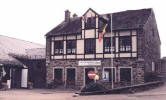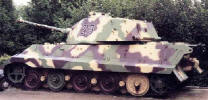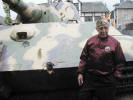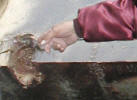
Historical Museum
This small, two-story museum in La Gleize is packed with a huge collection of WW-II artifacts, both Allied and German. |  Tiger II Tank Tiger II Tank
It is hard to miss this display item and it is in nearly pristine condition. The tank was one of six abandoned by troops under Kampfgruppe Peiper. Due to its 68 ton weight it ran at less than 22 miles per hour. It was a gas guzzler with a range of 100 miles presenting problems with supply logistics.
The gun turret housed an 88mm cannon. Armor plating made this beast almost invincible with 150mm of armor at the front and 185mm on the turret. As such there were few Allied weapons that could bring it down.
|  A Few Dents A Few Dents
show in this area of the tank's hull where it was peppered with small arms fire. The Tiger shook them of like pesky gnats and its crew would have been safe from harm's way..
On the front of the tank is a hole about six inches deep. On the side are small pockmarks made by a 50-caliber machine gun. Also, one of the tracks was knocked off. Armondo said that this was about the only way to stop a Tiger Tank.
|

508er Armondo Ortiz
poses in front of the Tiger. Note the three impact areas in the hull to the left of him |  Super Wedgee Super Wedgee
Armondo explained that the tank had been abandoned by its crew after it became wedged between two trees.
When the Americans got their hands on the tank they used it as a test specimen to see what weaponry would be most effective against this tank's tough hide.
The Tiger II stood almost unscathed after various high powered weapons, including bazookas, were fired at it. No shell were able to penetrate the hull.
|  Impervious Hull Impervious Hull
Armondo points to the largest and deepest pock mark left by those tests. According to Armondo, this 6 inch deep hole was caused by a 75 mm cannon shell.
Note that the shells generated enough heat and power to essentially melt the steel around the point of impact. Nonetheless there was enough hide left to prevent penetration and this steel rhinoceroses could keep going. "Knocking off a track was about the only way to stop them," said Armondo. |


